Finite Element Modeling of Multilayer Orthogonal Auxetic Composites under Low-Velocity Impact
Abstract
:1. Introduction
1.1. Auxetic Composites
1.2. FE Modeling of Impact on Foam-Filled Composites
2. FE Modeling of Auxetic Composite
2.1. Composite Structure and Parameters
2.2. Experimental Testing and FE Geometric Modeling
2.3. Element and Mesh Size
2.4. Material Modeling
2.5. Contact and Constraints
3. Results and Discussion
3.1. Deformation Process and Auxetic Effect
3.2. Poisson’s Ratio Versus Compressive Strain Curves
3.3. Contact Stress Versus Compressive Strain Curves
4. Conclusions
Acknowledgments
Author Contributions
Conflicts of Interest
References
- Choi, J.B.; Lakes, R.S. Fracture toughness of re-entrant foam materials with a negative Poisson’s ratio: Experiment and analysis. Int. J. Fract. 1996, 80, 73–83. [Google Scholar] [CrossRef]
- Ma, Z.D.; Bian, H.; Sun, C.; Hulbert, G.M.; Bishnoi, K.; Rostam-Abadi, F. Functionally-graded NPR (Negative Poisson’s Ratio) material for a blast-protective deflector. In Proceedings of the 2010 NDIA Ground Vehicle Systems Engineering and Technology Symposium Modeling & Simulation, Testing and Validation (Mstv) Mini-Symposium, Dearborn, MI, USA, 17–19 August 2010. [Google Scholar]
- Liu, Q. Literature Review: Materials with Negative Poisson’s Ratios and Potential Applications to Aerospace and Defense; Defense Science and Technology Organization: Fishermans Bend, VIC, Australia, 2006. [Google Scholar]
- Lakes, R.S. Foam structures with a negative Poisson’s ratio. Science 1987, 235, 1038–1040. [Google Scholar] [CrossRef] [PubMed]
- Chan, N.; Evans, K.E. Microscopic examination of the microstructure and deformation of conventional and auxetic foams. J. Mater. Sci. 1997, 32, 5725–5736. [Google Scholar] [CrossRef]
- Webber, R.S.; Alderson, K.L.; Evans, K.E. Novel variations in the microstructure of the auxetic microporous ultra-high molecular weight polyethylene. Part 1: Processing and microstructure. Polym. Eng. Sci. 2000, 40, 1894–1905. [Google Scholar] [CrossRef]
- Evans, K.; Nkansah, M.; Hutchinson, I.; Rogers, S. Molecular network design. Nature 1991, 353. [Google Scholar] [CrossRef]
- Alderson, K.L.; Alderson, A.; Smart, G.; Simkins, V.R.; Davies, P.J. Auxetic polypropylene fibres: Part 1—Manufacture and characterization. Plast. Rubber Compos. 2002, 31, 344–349. [Google Scholar] [CrossRef]
- Alderson, K.L.; Webber, R.S.; Kettle, A.P.; Evans, K.E. Novel fabrication route for auxetic polyethylene. Part 1. Processing and microstructure. Polym. Eng. Sci. 2005, 46, 568–578. [Google Scholar] [CrossRef]
- Liu, Y.P.; Hu, H.; Lam, J.K.C.; Liu, S. Negative Poisson’s ratio weft-knitted fabrics. Text. Res. J. 2010, 80, 856–863. [Google Scholar]
- Hu, H.; Wang, Z.Y.; Liu, S. Development of auxetic fabrics using flat knitting technology. Text. Res. J. 2011, 81, 1493–1502. [Google Scholar]
- Wang, Z.Y.; Hu, H. 3D auxetic warp-knitted spacer fabrics. Phys. Status Solidi B 2014, 251, 281–288. [Google Scholar] [CrossRef]
- Wang, Z.Y.; Hu, H.; Xiao, X.L. Deformation behaviors of three-dimensional auxetic spacer fabrics. Text. Res. J. 2014, 84, 1361–1372. [Google Scholar] [CrossRef]
- Zhang, Z.K.; Hu, H.; Xu, B.G. An elastic analysis of a honeycomb structure with negative Poisson’s ratio. Smart Mater. Struct. 2013, 22. [Google Scholar] [CrossRef]
- Alderson, K.L.; Simkins, V.R.; Coenen, V.L.; Davies, P.J.; Alderson, A.; Evans, K.E. How to make auxetic fibre reinforced composites. Phys. Status Solidi B 2005, 242, 509–518. [Google Scholar] [CrossRef]
- Hou, X.N.; Hu, H.; Silberschmidt, V. A novel concept to develop composite structures with isotropic negative Poisson’s ratio: Effects of random inclusions. Compos. Sci. Technol. 2012, 72, 1848–1854. [Google Scholar] [CrossRef]
- Hou, X.N.; Hu, H.; Silberschmidt, V. A composite material with Poisson’s ratio tunable from positive to negative values: An experimental and numerical study. J. Mater. Sci. 2013, 48, 8493–8500. [Google Scholar] [CrossRef]
- Hou, X.N.; Hu, H.; Silberschmid, V. Numerical analysis of composite structure with in-plane isotropic negative Poisson’s ratio: Effects of materials properties and geometry features of inclusions. Compos. Part B Eng. 2014, 58, 152–159. [Google Scholar] [CrossRef]
- Marc, S.; María, S.R.; Jordi, M. Photochemical Activation of Extremely Weak Nucleophiles: Highly Fluorinated Urethanes and Polyurethanes from Polyfluoro Alcohols. J. Org. Chem. 2014, 79, 5019–5027. [Google Scholar]
- Klempner, D.; Sendijarevic, V. Polymeric Foams and Foam Technology; Hanser Publishers: Munich, Germany, 2004; Chapter 1. [Google Scholar]
- Klempner, D.; Sendijarevic, V. Polymeric Foams and Foam Technology; Hanser Publishers: Munich, Germany, 2004; Chapter 3. [Google Scholar]
- Kreter, P.E. Polyurethane foam physical properties as a function of foam density. J. Cell. Plast. 1985, 21, 306–310. [Google Scholar] [CrossRef]
- Shen, H.B.; Steven, N. Mechanical characterization of short fiber reinforced phenolic foam. Compos. Part A 2003, 34, 899–906. [Google Scholar] [CrossRef]
- Das, D. Reinforcement of Syntactic Foam with Silicon Carbide Nanoparticles; Florida Atlantic University: Boca Raton, FL, USA, 2009. [Google Scholar]
- Evans, K.E.; Alderson, A. Auxetic Materials: Functional materials and structures from lateral thinking! Adv. Mater. 2000, 12, 617–628. [Google Scholar] [CrossRef]
- Scarpa, F.; Yates, J.; Ciffo, L.; Patsias, S. Dynamic crushing of auxetic open-cell polyurethane foam. Proc. Inst. Mech. Eng. Part C 2002, 216, 1153–1156. [Google Scholar] [CrossRef]
- Scarpa, F.; Ciffo, L.; Yates, J. Dynamic properties of high structural integrity auxetic open cell foam. Smart Mater. Struct. 2004, 13. [Google Scholar] [CrossRef]
- Alderson, K.L.; Pickles, A.P.; Neale, P.J.; Evans, K.E. Auxetic polyethylene: The effect of a negative Poisson’s ratio on hardness. Acta Metall. Mater. 1994, 42, 2261–2266. [Google Scholar] [CrossRef]
- Alderson, K.L.; Fitzgerald, A.F.; Evans, K.E. The strain dependent indentation resilience of auxetic microporous polyethylene. J. Mater. Sci. 2000, 35, 4039–4047. [Google Scholar] [CrossRef]
- Jiang, L.L.; Gu, B.H.; Hu, H. Auxetic composite made with multilayer orthogonal structural reinforcement. Compos. Struct. 2016, 135, 23–29. [Google Scholar] [CrossRef]
- Jiang, L.L.; Hu, H. Low-velocity impact response of multilayer orthogonal structural composite with auxetic effect. Compos. Struct. 2017, 169, 62–68. [Google Scholar] [CrossRef]
- Santosa, S.; Wierzbicki, T. Crash behavior of box columns filled with aluminum honeycomb or foam. Comput. Struct. 1998, 68, 343–367. [Google Scholar] [CrossRef]
- Santosa, S.; Wierzbicki, T.; Hanssen, A.G.; Langseth, M. Experimental and numerical studies of foam-filled sections. Int. J. Impact Eng. 2000, 24, 509–534. [Google Scholar] [CrossRef]
- Kostopoulos, V.; Markopoulos, Y.P.; Giannopoulos, G.; Vlachos, D.E. Finite element analysis of impact damage response of composite motorcycle safety helmets. Compos. Part B 2002, 33, 99–107. [Google Scholar] [CrossRef]
- Dou, R.; Qiu, S.; Ju, Y.; Hu, Y. Simulation of compression behavior and strain-rate effect for aluminum foam sandwich panels. Comput. Mater. Sci. 2016, 112, 205–209. [Google Scholar] [CrossRef]
- Li, J.; Ma, G.; Zhou, H.; Du, X. Energy Absorption Analysis of Density Graded Aluminium Foam. Int. J. Prot. Struct. 2011, 2, 333–349. [Google Scholar] [CrossRef]
- Jörgen, S. Bergström, Advanced Finite Element Modeling of Polymer Foam Components. In Proceedings of the ABAQUS Users’ Conference, Cambridge, MA, USA, 23–25 May 2006. [Google Scholar]
- Briody, C.; Duignan, B.; Jerrams, S. Characterisation, material modelling and simulation of flexible polyurethane foam. In Proceedings of the International Conference on Materials, Tribology and Recycling (MATRIB), Vela Luka, Croatia, 29 June–1 July 2011. [Google Scholar]
- Lyn, G.; Mills, N.J. Design of foam crash mats for head impact protection. Sports Eng. 2001, 4, 153–163. [Google Scholar] [CrossRef]
- Brian, C.; Hubert, L. Selecting Material Models for the Simulation of Foams in LS-DYNA. In Proceedings of the 7th European LS-DYNA Conference, Salzburg, Austria, 14–15 May 2009. [Google Scholar]
- LS-Dyna Theory Manual, 2006; Livermore Software Technology Corporation: Livermore, CA, USA, 2006.
- LS-Dyna Version 970 Keyword User’s Manual; Livermore Software Technology Corporation: Livermore, CA, USA, 2006.
- Ozturk, U.E.; Anlas, G. Finite element analysis of expanded polystyrene foam under multiple compressive loading and unloading. Mater. Des. 2011, 32, 773–780. [Google Scholar] [CrossRef]
- Ozturk, U.E. Mechanical Behavior of Low Density Polymeric Foams under Multiple Loading and Unloading. Ph.D. Thesis, Bogazici University, Istanbul, Turkey, 2008. [Google Scholar]
- LS-DYNA. Available online: http://www.lstc.com/products/ls-dyna (accessed on 3 August 2017).
- ANSYS LS-DYNA. Available online: http://www.ansys.com/products/structures/ansys-ls-dyna (accessed on 3 August 2017).
- Zhou, L.; Jiang, L.L.; Hu, H. Auxetic composites made of 3D textile structure and polyurethane foam. Phys. Status Solidi B 2016, 253, 1331–1341. [Google Scholar] [CrossRef]
- ANSYS 13.0 Help, ANSYS, Inc.: Pittsburgh, PA, USA.
- Bala, S. Best Practices for Modeling Recoverable Low Density Foams—By Example. 2006. Available online: http://blog2.d3view.com/bestpractices-for-modeling-recoverable-low-density-foams-by-example/ (accessed on 3 August 2017).
- Weimar, K.; Day, J. Negative Volumes in Brick Elements. 2003. Available online: http://www.dynasupport.com/howtos/element/negativ-volumes-in-brick-elements (accessed on 3 August 2017).
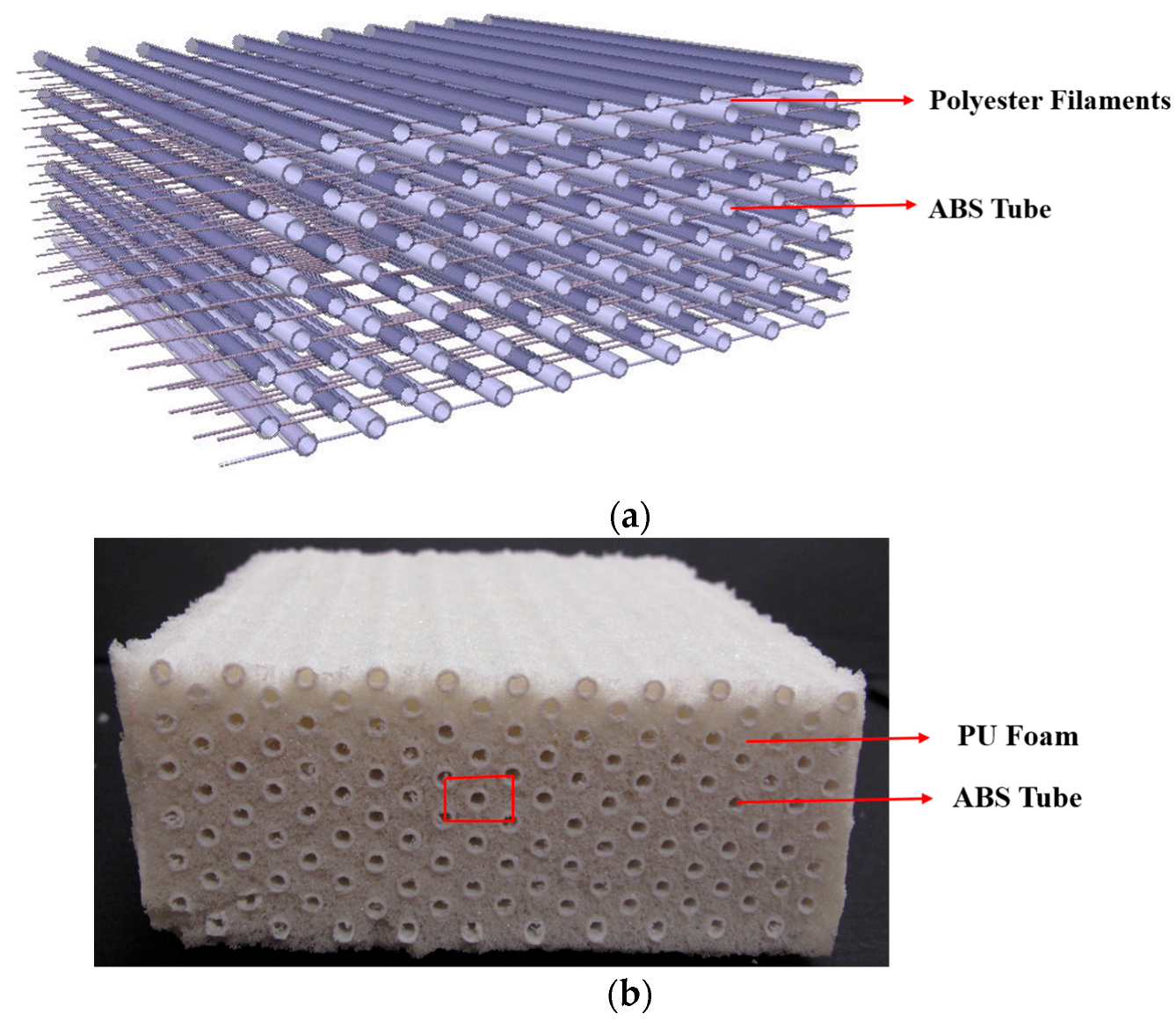
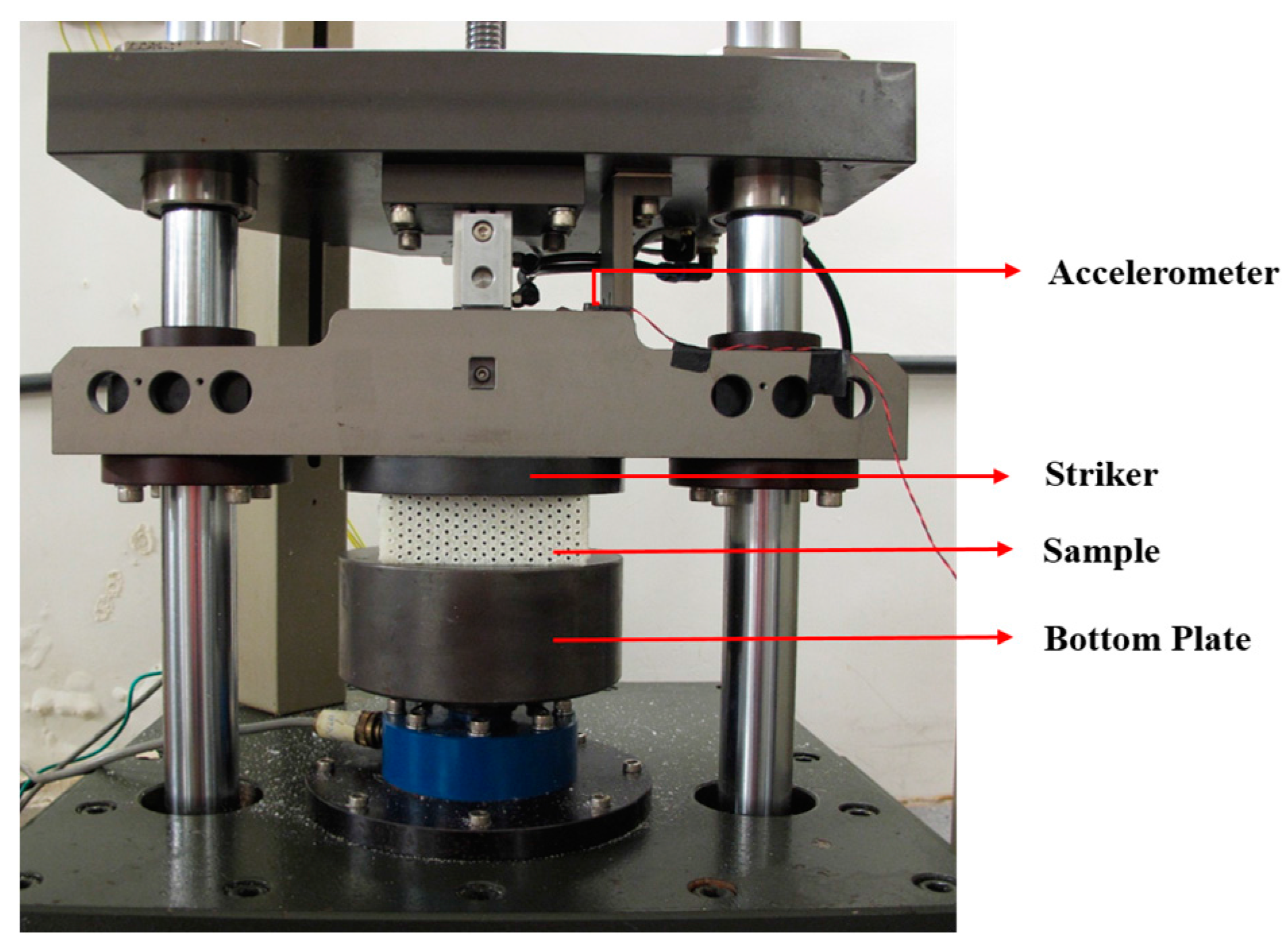
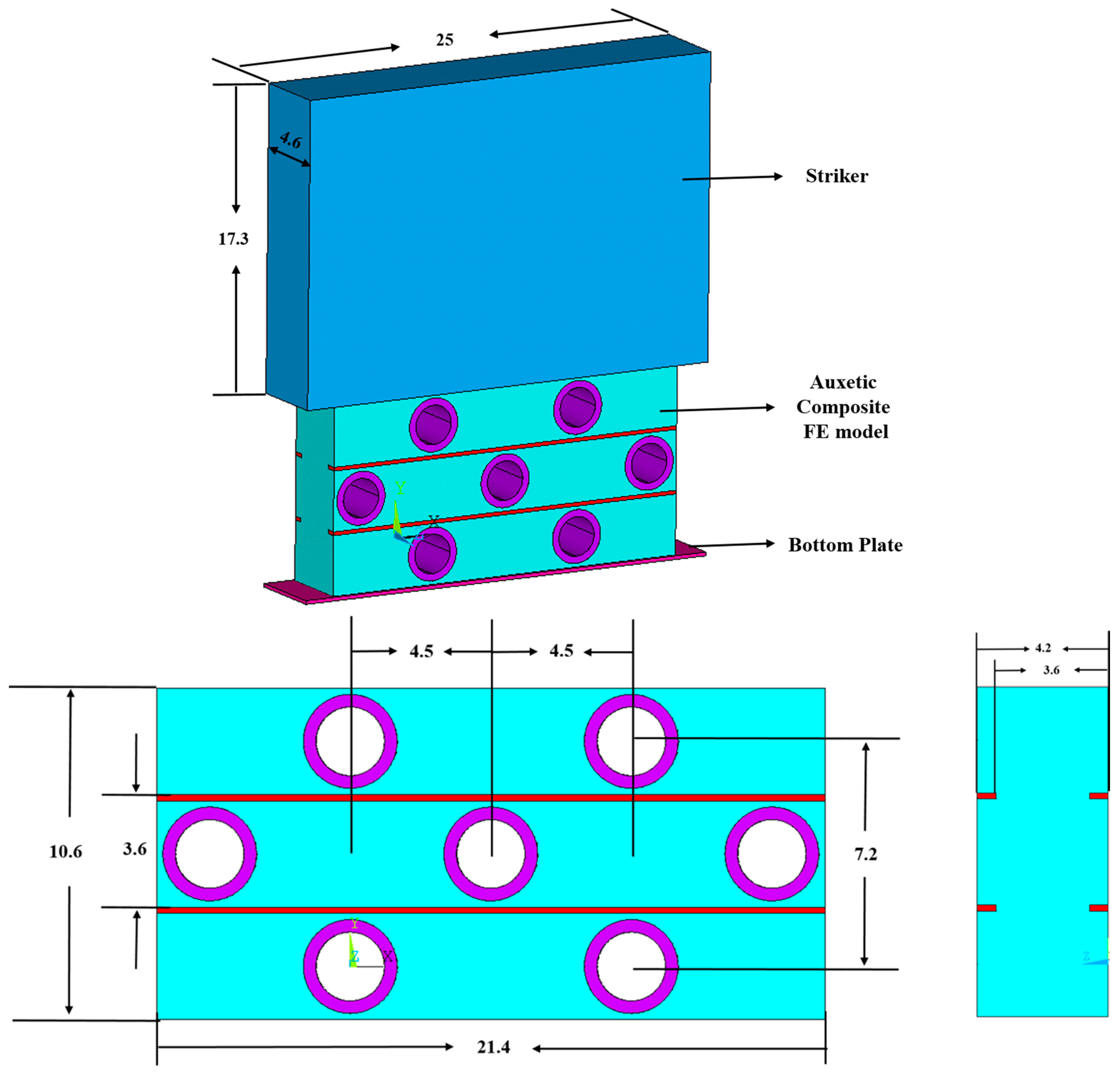

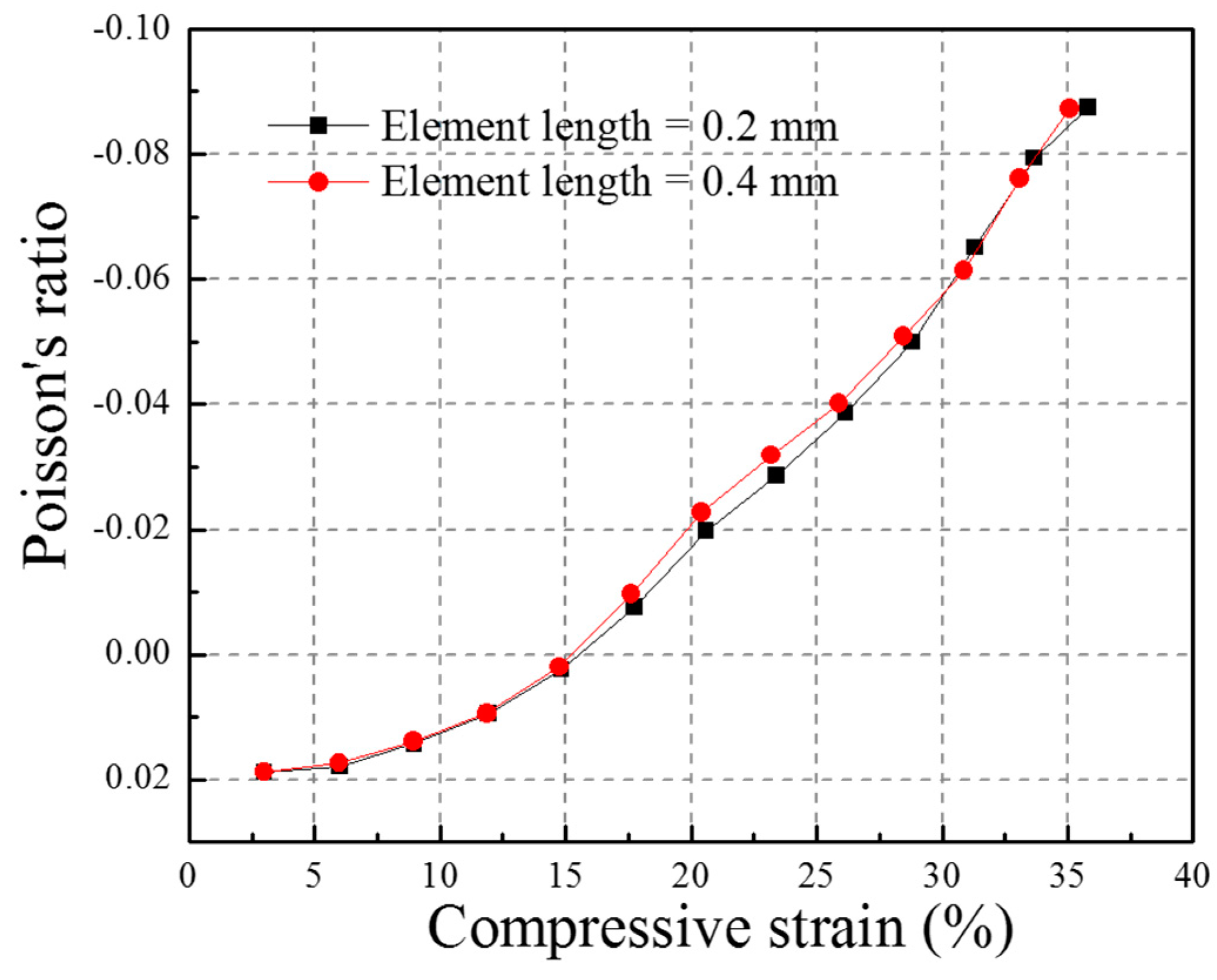
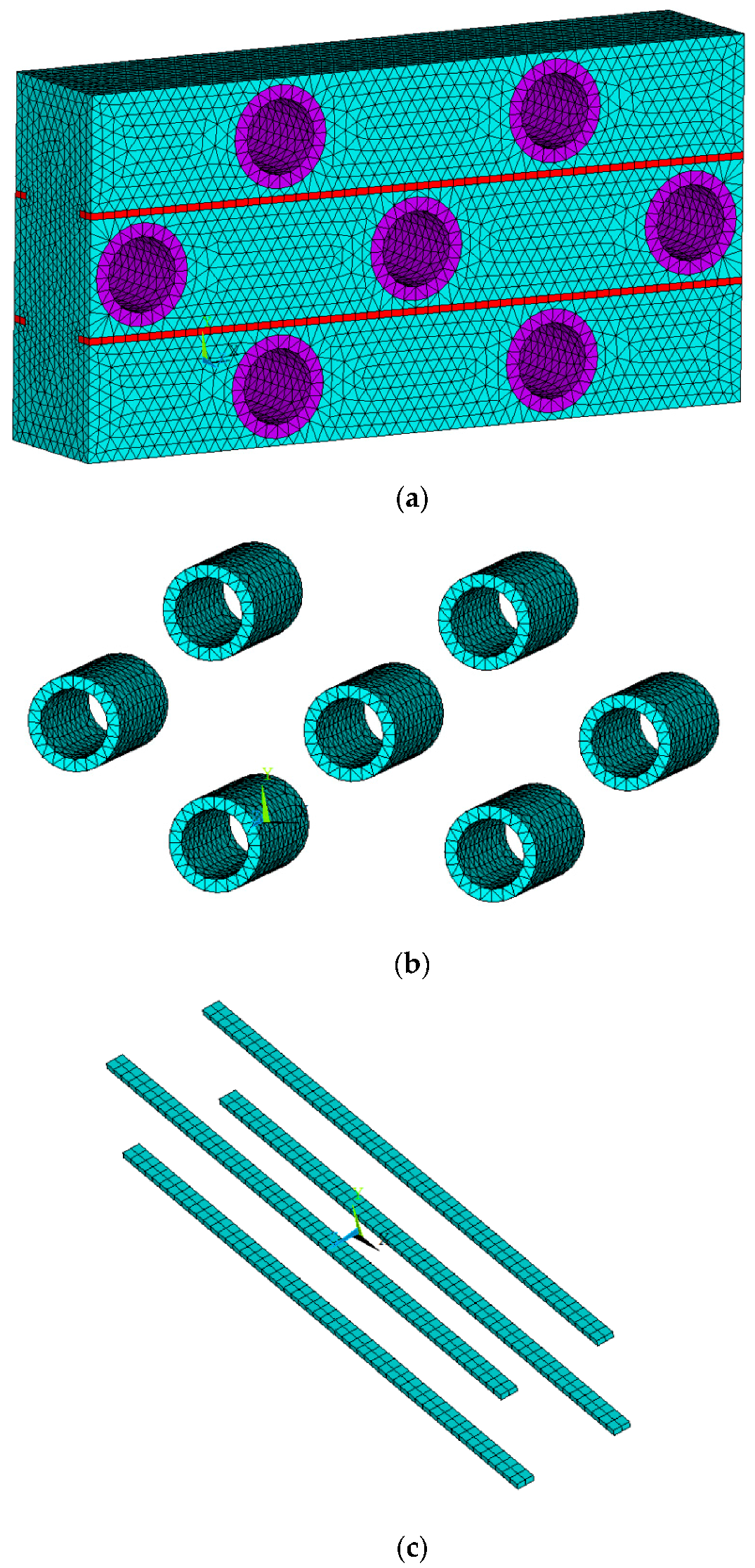
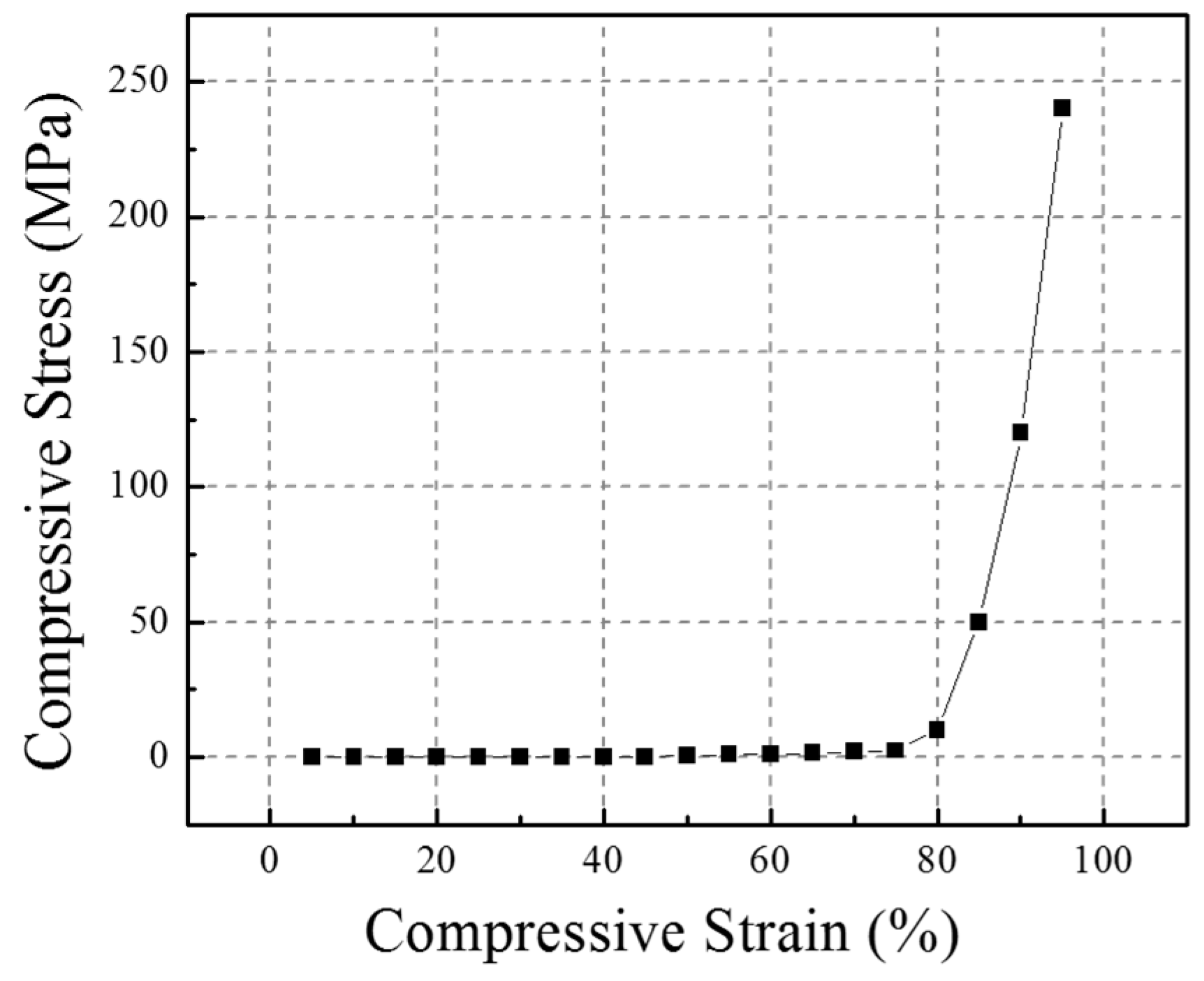
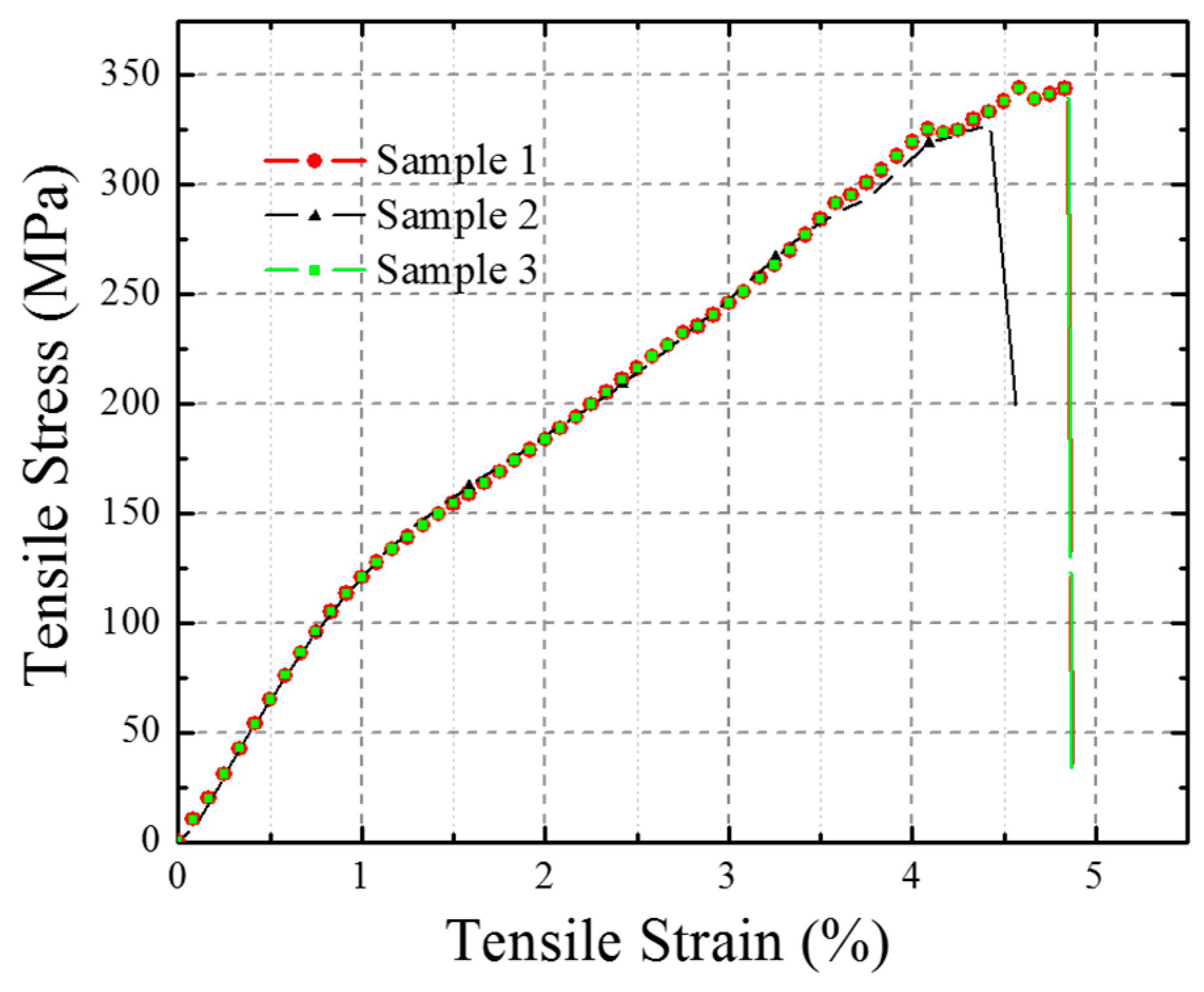
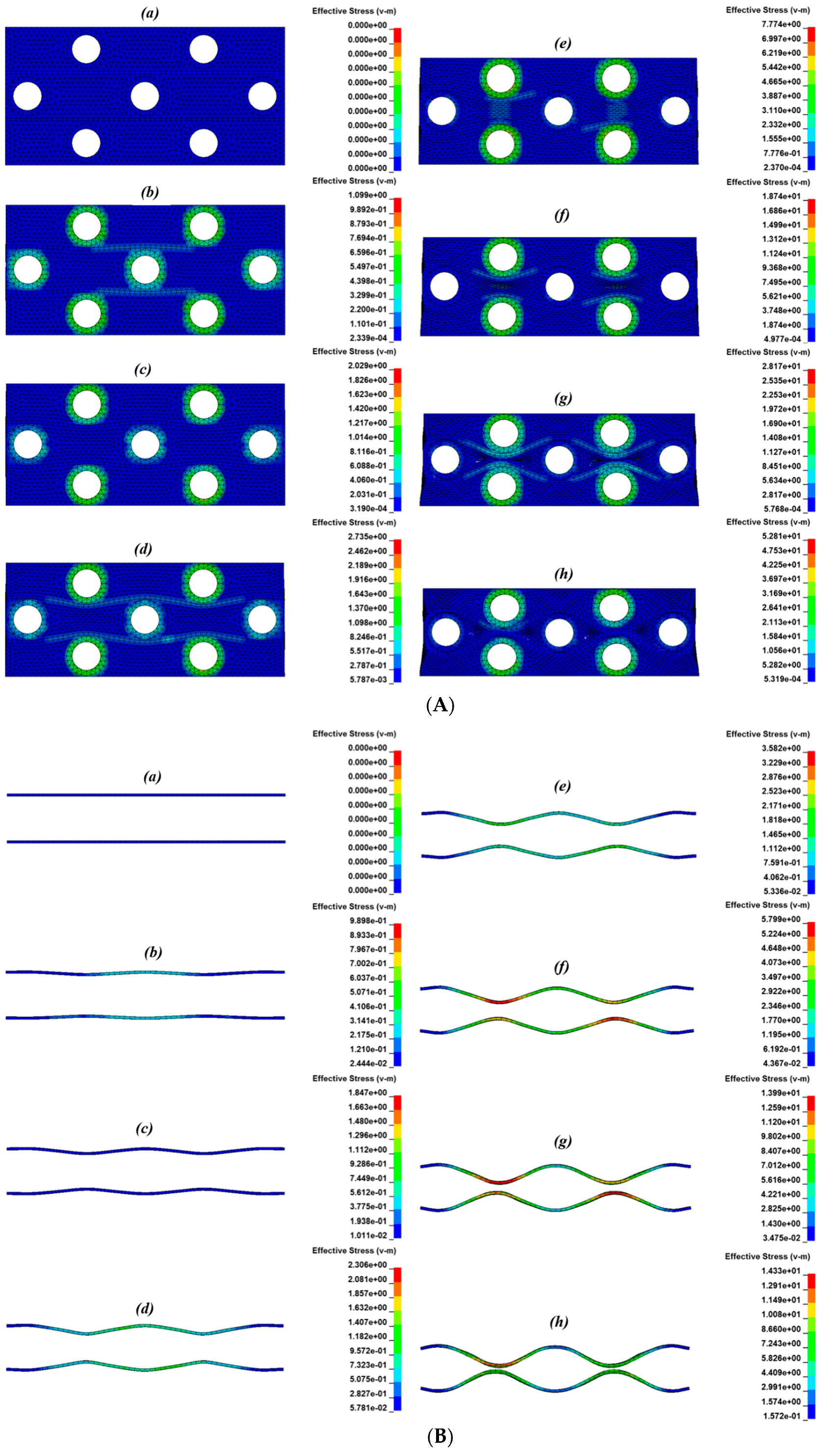

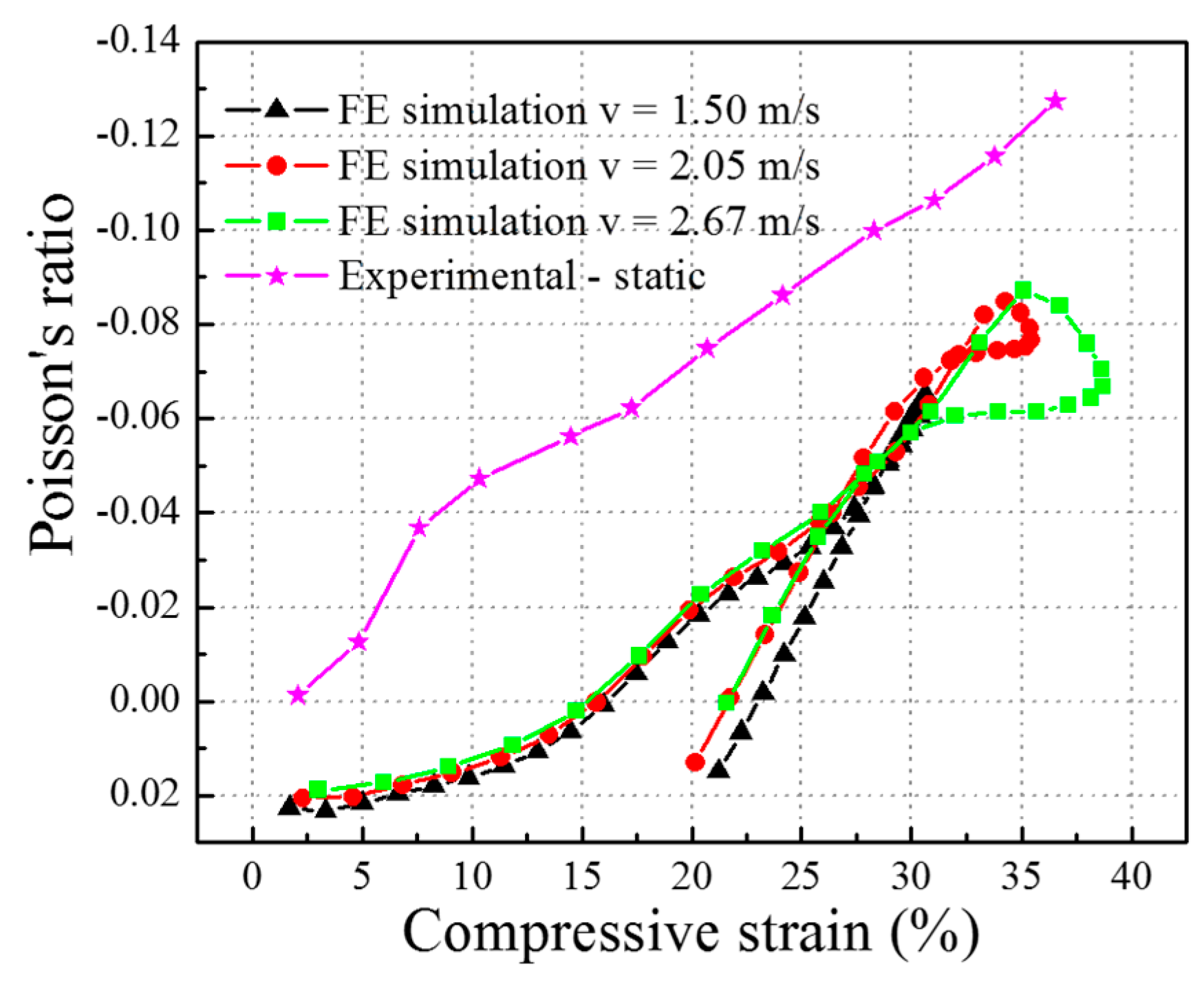
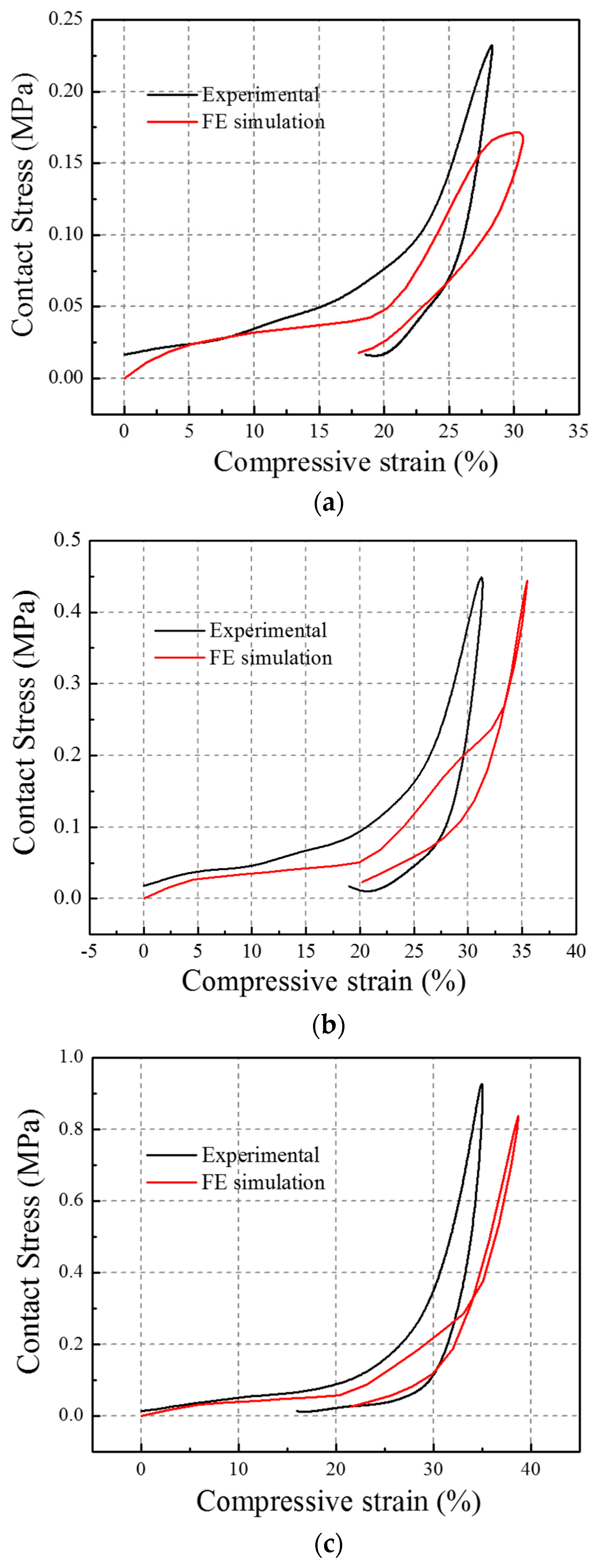
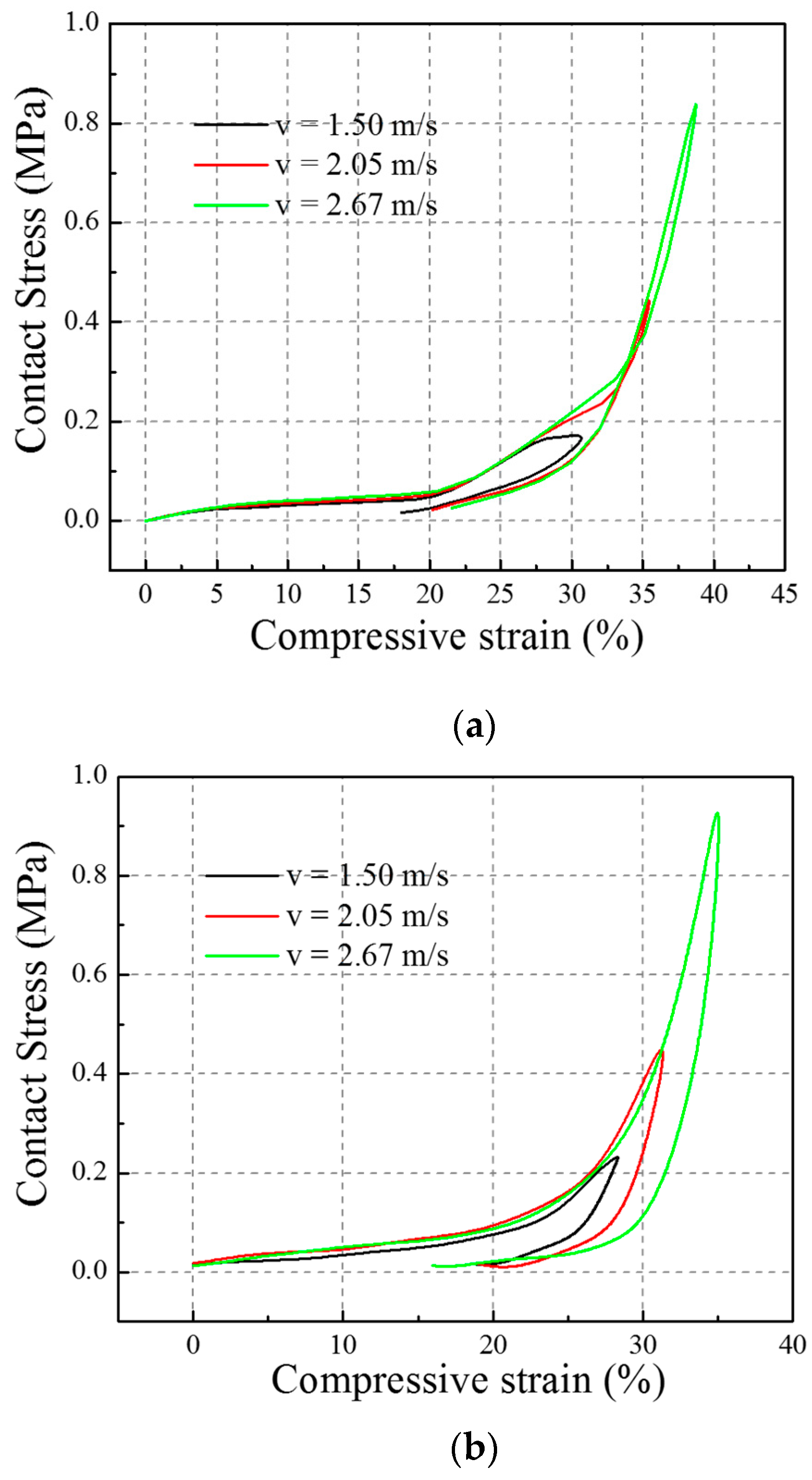
| The Polyester Filaments | The ABS Tubes | ||
|---|---|---|---|
| Material density | 1.38 g/cm3 | Material density | 1.05 g/cm3 |
| Yarn linear density | 1670 dtex (456 f) | Elastic modulus = 2.2 GPa | 2.2 GPa |
| Elastic modulus | 12.77 GPa | Bending modulus | 28 GPa |
| Fracture stress | 345.29 MPa | Poisson’s ratio | 0.394 |
| Fracture strain | 4.63% | Outer Diameter | 3 mm |
| Impact Velocity/m/s | Initial Young’s Modulus/Mpa (Exp) | Initial Young’s Modulus/Mpa (FE) | Difference/% | Maximum Compressive Strain/% (Exp) | Maximum Compressive Strain/% (FE) | Difference/% | Peak Contact Stress/MPa (Exp) | Peak Contact Stress/MPa (FE) | Difference/% |
|---|---|---|---|---|---|---|---|---|---|
| 1.50 | 0.21 | 0.34 | 61.90 | 28.33 | 30.68 | 8.30 | 0.23 | 0.17 | 26.09 |
| 2.05 | 0.39 | 0.55 | 41.03 | 31.32 | 35.45 | 13.19 | 0.45 | 0.44 | 2.22 |
| 2.67 | 0.41 | 0.58 | 41.46 | 35.05 | 38.70 | 10.41 | 0.93 | 0.84 | 9.68 |
© 2017 by the authors. Licensee MDPI, Basel, Switzerland. This article is an open access article distributed under the terms and conditions of the Creative Commons Attribution (CC BY) license (http://creativecommons.org/licenses/by/4.0/).
Share and Cite
Jiang, L.; Hu, H. Finite Element Modeling of Multilayer Orthogonal Auxetic Composites under Low-Velocity Impact. Materials 2017, 10, 908. https://doi.org/10.3390/ma10080908
Jiang L, Hu H. Finite Element Modeling of Multilayer Orthogonal Auxetic Composites under Low-Velocity Impact. Materials. 2017; 10(8):908. https://doi.org/10.3390/ma10080908
Chicago/Turabian StyleJiang, Lili, and Hong Hu. 2017. "Finite Element Modeling of Multilayer Orthogonal Auxetic Composites under Low-Velocity Impact" Materials 10, no. 8: 908. https://doi.org/10.3390/ma10080908




